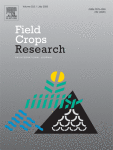Ver ítem
- xmlui.general.dspace_homeCentros Regionales y EEAsCentro Regional Buenos Aires SurEEA BalcarceArtículos científicosxmlui.ArtifactBrowser.ItemViewer.trail
- Inicio
- Centros Regionales y EEAs
- Centro Regional Buenos Aires Sur
- EEA Balcarce
- Artículos científicos
- Ver ítem
Does the photo-thermal environment limit post-flowering maize growth?
Resumen
After canopy closure and in the absence of limitations by water or nutrient availability, crop growth rate (CGR) of maize (Zea mays L.) is ultimately constrained by the daily incident radiation and temperature of the environment. Sustaining maximal canopy photosynthetic capacity after-flowering is, then, a necessary but not a sufficient condition to increase maize dry-matter production. The aim of the present study was to determine the extent of the
[ver mas...]
After canopy closure and in the absence of limitations by water or nutrient availability, crop growth rate (CGR) of maize (Zea mays L.) is ultimately constrained by the daily incident radiation and temperature of the environment. Sustaining maximal canopy photosynthetic capacity after-flowering is, then, a necessary but not a sufficient condition to increase maize dry-matter production. The aim of the present study was to determine the extent of the photo-thermal environment limitation to CGR during the post-flowering period in current maize crops. Dynamic of CGR was studied in two well-irrigated and nourished maize field experiments (Exp. 1 and Exp. 2 for 2010−11 and 2011−12 cropping seasons, respectively) on conventional crops (i.e. full-season hybrid planted early in the season) at Balcarce, Argentina (37° 45’ S, 58° 18’ W; 130 m a.s.l.). Two independent methods were performed to benchmark the CGR of these conventional crops during the post-flowering period: i) empirical CGR values obtained under the same weather conditions from younger maize crops, and ii) theoretically estimated potential CGR, obtained as a function of daily incident radiation and potential radiation use-efficiency (RUE). Conventional crops reached the maximal CGR near flowering in mid-January, being 51.2 g m−2 d−1 and 58.8 g m−2 d−1 in Exp. 1 and Exp. 2, respectively. Afterwards, CGR decreased progressively towards crops maturity late in March. Estimates, from either the empirical or the theoretical method, indicated that although attainable-CGR decreases progressively towards the end of the cropping season, it sustains higher values than those achieved by conventional crops after flowering. Differences in attainable vs. actual-CGR was almost exclusively attributable to RUE, which, in turn, could not be explained solely by the post-flowering foliar nitrogen withdrawal. Differences between actual (1987 g m−2 in Exp. 1 and 1614 g m−2 in Exp. 2) and potential post-flowering dry-matter production defined gaps that were in the range 18.2%–47.8%. From these results, it can be concluded that the photo-thermal environment is not, at least so far, the limiting factor to the post-flowering maize growth. Further research is needed, however, to analyze the viability of increasing potential yield of maize through the closure of these estimated gaps.
[Cerrar]

Fuente
Field Crops Research 252 : 107805 (2020)
Fecha
2020-07-01
Editorial
Elsevier
ISSN
0378-4290
Formato
pdf
Tipo de documento
artículo
Palabras Claves
Derechos de acceso
Restringido
 Excepto donde se diga explicitamente, este item se publica bajo la siguiente descripción: Creative Commons Attribution-NonCommercial-ShareAlike 2.5 Unported (CC BY-NC-SA 2.5)
Excepto donde se diga explicitamente, este item se publica bajo la siguiente descripción: Creative Commons Attribution-NonCommercial-ShareAlike 2.5 Unported (CC BY-NC-SA 2.5)

